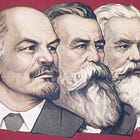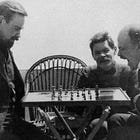Architectural Inversion
How Revolutionary Theory Became the Blueprint for Centralised Control
Most people read Marx, Engels, Lenin, and Bogdanov as champions of worker liberation. But there's another way: as a technical manual for centralised control. The same theories that promise emancipation also describe how to build comprehensive systems of surveillance, coordination, and rationing. The key insight is simple: whoever controls the measurements and the money controls everything else.
The Stack: Metric → Telemetry → Ledger → Eligibility
Marx's Capital isn't just political economy; it's a technology stack:
Metric (Vol. I): Marx begins by defining ‘Socially Necessary Labour Time’ as the universal yardstick for value. On the surface it looks like neutral science: one can now compare a weaver's work to a carpenter's or a miner's. But the category only works if a central authority decides what counts as ‘necessary’ and related conversion factors. Is the fast worker or the average one the benchmark? Do obsolete techniques still count? What about local variation in conditions? To define a ‘universal’ standard, the system must strip away all context and enforce a single measure from above. Once in place, this metric lets labour itself be reduced to numbers — a necessary precondition for constant comparison, auditing, and discipline.
Telemetry (Vol. II): If Volume I provides the ruler, Volume II provides the map. Marx traces how commodities move through different ‘departments’ of the economy: production of consumer goods, production of producer goods, circulation of capital, and so on. In a market, prices handle this coordination invisibly. In a planned system without prices, the only way to keep the flows balanced is through continuous monitoring of every input and output. Telemetry becomes indispensable. Grain shipments, steel output, electricity loads — all must be tracked in real time. Without this visibility, shortages or gluts ripple uncontrollably. Thus surveillance of flows is not incidental but structural: the system cannot function without always-on monitoring.
Apex Ledger (Vol. III): Here Marx turns to finance. Credit and banking, he writes, are the ‘universal book-keeping’ of the capitalist system, the coordinating brain that settles all accounts. In a planned society this role intensifies: the ledger is no longer just a record but the final authority. Every transfer, loan, and payment flows through it, and whoever maintains it holds the real power to validate or deny economic life. In theory, this ledger could be democratic. In practice, as Lenin discovered, it concentrates power in the institutions that run it. The ledger is the choke point: whoever operates it doesn't just observe the economy, they govern it.
Eligibility (Gotha Programme): Marx's labour vouchers are often presented as a humane transition device: workers receive credits equal to their labour contribution, exchangeable for goods. But they are explicitly not money. They cannot circulate, cannot be hoarded, and can be programmed to expire. That design transforms them into vouchers, ration coupons, or permission slips. Abolishing money doesn't erase the need for coordination — it multiplies it. Without prices, the state must track every labour contribution and every material flow in order to issue the right vouchers and allocate the right goods. This demands universal surveillance and universal accounting. What appears as liberation from money is in fact its metamorphosis into a fully administered ledger, where distribution is inseparable from control.
But machinery like this doesn’t install itself; it first needs mass mobilisation and a horizon that makes centralisation feel like ‘liberation’ — enter the Manifesto and the Grundrisse.
Before the technical manuals comes the sales pitch. The Communist Manifesto is less an analysis than a mobilisation strategy. It supplies the emotional fuel to tear down existing institutions: the drama of class struggle, the villainy of the bourgeoisie, the heroic destiny of the proletariat. But beyond rhetoric, the famous Ten Planks read like an instruction sheet for centralisation. Nationalise transport and communications. Centralise credit in a national bank. Expand state-run education. Confiscate property and apply rents for state purposes. Each step dissolves dispersed authority — family, local community, guild, church — and folds it into a single coordinating apparatus. In this sense, the Manifesto is not just a call to arms; it's the marketing campaign for the stack that will later be formalised in Capital and Gotha.
The Grundrisse reveals the end game. The private notebooks later published as the Grundrisse are where Marx allows himself to think beyond the mechanics of labour and capital. The most famous passage, the ‘Fragment on Machines’, describes a turning point: when technology and science — the ‘general intellect’ of society — become the primary productive force. In this stage, value no longer derives directly from labour time but from control of knowledge embedded in automated systems. For Marx this was an anticipation of post-labour abundance. Read in inversion, it is something else: the moment when power shifts decisively from workers to those who control information systems — a technocracy. Algorithms, models, and technical apparatus displace human labour as the coordinating principle. Here lies the intellectual foundation of technocracy — rule not by people, but by the administrators of knowledge machines.
With mobilisation and horizon in place, the remaining question is simple: who actually drives the machine?
Lenin's Flip
Marx assumed that once capitalism's machinery was captured, workers would run it in their own interest. Lenin discovered otherwise. In practice, the decisive lever was not factories or parliaments but the ledger itself. Whoever controlled the system of accounts controlled the state.
His doctrine of ‘accounting and control’ revealed that financial infrastructure is the real sovereign. Money creation, credit allocation, settlement rules — these define what governments can and cannot do. The state does not master the bank; the bank, by validating or denying transactions, masters the state.
Bogdanov's Completion
Where Marx outlined the mechanics and Lenin identified the lever of power, Bogdanov built the operating system. He translated abstract theory into tools for organising society as a coherent whole.
Empiriomonism: a philosophical wrapper that frames political choices as neutral science. Decisions are presented as objective analysis, even though the analysts are the same authorities who enforce the rules. This is the direct ancestor of contemporary ‘evidence-based policy’ and ‘data-driven governance’.
Proletkult: a cultural programme ensuring art, education, and media embed the system's priorities. Instead of propaganda imposed from outside, values are internalised, so people reproduce the ‘correct’ logic themselves.
Tektology: a universal science of organisation that treats every process as flows of inputs and outputs. Human society becomes analysable like machinery, subject to adjustment and optimisation.
Bogdanov's contribution was not just theory but closure: he supplied the cultural, organisational, and philosophical components needed to make the Marxist stack a fully self-reinforcing system.
The Inversion Architecture
Taken together, Marx, Lenin, and Bogdanov built not just a theory of liberation but a hierarchical control system. What looks like a moral project of emancipation becomes a recursive loop of measurement, monitoring, and allocation. The architecture can be mapped onto Erich Jantsch's purposive–normative–pragmatic–empirical hierarchy — but with a decisive inversion that reveals the system's true operational logic.
This same architectural pattern aligns with Alfred Zimmern's ‘Third British Empire’, which explicitly calls for ‘international social justice’ which is to be delivered through economics — moral purposes at the purposive level implemented through economic control at the empirical level. Zimmern's framework abandoned territorial conquest in favor of administrative coordination justified by universal principles.
Eduard Bernstein's ‘Evolutionary Socialism’ followed identical logic, advocating public-private partnerships to achieve social justice through gradual economic coordination rather than revolutionary transformation. Both frameworks demonstrate that this inversion logic transcends specific ideological content, appearing whether the approach is revolutionary Marxism, imperial administration, or reformist social democracy.
Both Zimmern and Bernstein replace territorial force with administrative control via credit, standards, and settlement.
Two hierarchies coexist: the stated hierarchy (purpose → norms → practice → data) and the operational hierarchy (settlement control defines ends and pushes upward). The below traces both.
Purposive: Moral Framework (Gotha + Manifesto): Justice, fairness, equality, worker liberation — these supply the ultimate ends and emotional energy. They provide the moral legitimacy that makes the entire system feel necessary and righteous. The moral framework operates as the system's public face and source of meaning.
Normative: Measurement (Vol. I): ‘Socially Necessary Labour Time’ becomes the ‘fair’ standard that implements those moral values. It translates abstract justice into concrete metrics, creating commensurable units that can be compared, audited, and managed. The measurement framework makes moral principles operational.
Pragmatic: Monitoring (Vol. II): Flow tracking becomes the coordination method needed to achieve fairness. Without market prices, comprehensive surveillance of all inputs and outputs becomes the practical requirement for maintaining system balance. Monitoring transforms moral commitments into administrative necessity.
Empirical: Control (Vol. III): The apex ledger provides the concrete implementation through whoever controls the unit of account and settlement. This is where actual power operates — through the mundane reality of who processes transactions, defines what counts as valid economic activity, and maintains the universal book-keeping system.
The inversion reveals itself clearly: moral purposes operate at the stated purposive level while concrete control functions at the empirical level. The system presents itself as flowing from high moral principles down to technical implementation, but actual power flows upward from control of money and settlement to shape all higher levels. Those who control the empirical reality of economic coordination end up defining what the moral principles mean in practice.
Bogdanov's sophistication becomes clear when viewed through Jantsch's framework: his three systems function as the crucial bridging mechanisms between hierarchical levels. Empiriomonism operates as the systems design laboratory at the Purposive-Normative interface, translating ultimate moral ends into operational principles through 'collectively subjective' interpretation of material fact — data. Proletkult works as the function-oriented department at the Normative-Pragmatic interface, embedding principles into cultural practices through art, education, and media programming. Tektology functions as the discipline-oriented department at the Pragmatic-Empirical interface, converting coordination methods into actual organisational reality through systems analysis of flows and outputs. These are systematic translation mechanisms that make the inversion functionally viable, allowing empirical control to flow upward while moral purposes flow downward as legitimating cover.
The system then loops back: control is re-presented as moral necessity. Scarcity or breakdowns don't threaten the loop; they reinforce it. When reality intrudes — ecological limits, shortages, cultural resistance — the system doesn't adapt or retreat. Instead, it clogs, and this clogging becomes the justification for tighter allocation control at the apex. Each crisis proves the system's importance rather than revealing its failures:
Supply chain disruptions require more monitoring.
Financial instability demands more central coordination.
Social unrest calls for enhanced surveillance.
The failures become the evidence for expanding exactly the mechanisms that produced them. What looks like abundance is simply the system balancing its own signals while tightening control over real inputs, creating a self-reinforcing spiral where each collision with reality strengthens rather than weakens the control architecture.
The inversion is complete. What presents itself as purposive morality becomes normative cover for empirical control. The ledger becomes the hidden foundation that defines everything else, while moral frameworks provide the legitimating overlay that makes comprehensive coordination feel like justice rather than domination.
Who Controls the Operating System?
Not workers. The winners are those who control money and measurement infrastructure — central banks.
Marx's ‘abolition of money’ doesn't erase financial coordination; it perfects it. Once market prices are gone, the state must both distribute vouchers and monitor all material flows. Without prices, there is no coordination except through surveillance and centralised accounting. What looks like liberation becomes a totalising apparatus of measurement and control.
Money becomes administrative entries on a master ledger, every transaction and allocation pre-approved. Workers are the operating system, but banks are the administrators with root access. Elected officials are reduced to ceremony while central banks act as the real government.
How This Plays Out Today
This system was not installed overnight by revolution; it evolved through institutions. Marx's universal book-keeping (Volume III) prefigures both Gosplan's material balance sheets and the Pentagon's Planning-Programming-Budgeting System (PPBS), which later exported to the World Bank and UN frameworks. Its core elements are already visible:
CBDCs: programmable credits indistinguishable from Marx's labour vouchers. They can expire, carry spending restrictions, or limit use to certain geographies. The moral inversion is striking: Marx frames these vouchers as justice and fairness, but the functional reality is programmable rationing tokens.
ESG scoring: morality embedded directly into financial infrastructure, conditioning access to loans and investment.
Real-time transaction monitoring: the digital equivalent of Marx's compulsory surveillance of flows. Every purchase, transfer, and contract is tracked, producing the telemetry the system requires.
Programmable money: rules migrate from outside money to inside it. Instead of laws restricting transactions, the money itself carries the restrictions.
Falsifiable Signposts
The inversion thesis can be tested. Watch for these safeguards:
Cash parity: legal protection for cash as an alternative
Retail CBDC guarantees: explicit prohibitions on purpose-gating or hidden programmability
Scope firewalls: bans on using payment rails for non-financial policy enforcement
Energy abundance: nuclear build-out that makes rationing unnecessary
Plural settlement systems: multiple competing rails instead of a single apex ledger
If these safeguards vanish, the architecture Marx sketched is no longer theoretical — it has been realised.
Yet institutional incentives work strongly against implementing any of these protections. Cash undermines the comprehensive transaction visibility that the system requires. Non-programmable CBDCs abandon the control capabilities that make digital currency attractive to central banks. Scope firewalls prevent policymakers from using payment systems to enforce climate, health, and social policies — precisely the integration that contemporary governance demands. Energy abundance eliminates the scarcity that justifies technocratic rationing and allocation systems through ‘energy certificates’, contemporarily inversed through carbon emission permit-backed CBDCs. Plural settlement rails distribute the apex ledger control that currently concentrates power in central banking networks.
Each safeguard directly threatens the functional requirements of the coordination system Marx theoretically specified and that central banks now operationally control. The safeguards aren't just politically difficult — they're architecturally incompatible with the system's core logic. This makes their absence not merely probable but structurally predictable.
What Marx envisioned as liberation has matured into a control architecture where finance, morality, and surveillance converge.
Conclusion
Marx's architecture is not just a political theory but a living grammar of control. Its structure is asymmetric: morality flows downward as justification, while control flows upward into the apex ledger. Each crisis strengthens this loop, tightening allocation and permissions until daily life itself is programmable.
The alternative is systems that distribute authority downward, and this difference can be mapped directly against Jantsch's hierarchy:
In the inverted Marxist stack, Moral Framework (Gotha + Manifesto) becomes the stated purposive layer; Measurement (Vol. I) functions as normative standards; Monitoring (Vol. II) operates as pragmatic coordination; and Control (Vol. III) provides the empirical foundation through whoever controls the unit of account and settlement. The loop runs in reverse: empirical control defines the real purpose, while moral frameworks provide legitimating cover.
The Manifesto functions as the sales pitch, while the Grundrisse points to automation and the ‘general intellect’ where control shifts from labour to the administrators of machines. These bookends give the stack its emotional entry point and its technological endgame.
Safeguards can hold the line — cash guarantees to preserve free exchange, privacy in digital currencies, firewalls against using payment rails for social engineering, plural settlement systems to prevent monopolisation, energy abundance that strips away rationing’s pretext, and above all, awareness of what is actually happening rather than what we are told. Ask questions. Challenge narratives. Press local politicians. Rock the boat. Yet safeguards alone are fragile if the deeper design logic remains inverted.
The inverted system mirrors Technocracy, Inc. so closely that chance is an inadequate explanation. The alignment is too precise, across too many domains, to be coincidence.
Common Objections Answered
‘AI solves the calculation problem’
Even the best computers can't capture local, tacit knowledge. Without prices, the system falls back on surveillance and permissions.‘Worker co-ops prove Marx right’
Co-ops rely on prices and money. They are not examples of Marx's moneyless plan.‘Digital currencies are just efficient’
The capacity for control creates pressure to use it. Restrictions are easy to add, hard to remove.‘Standards are neutral’
Metadata and purpose codes embed policy into infrastructure. Once present, controls become cheap to enforce and costly to unwind.‘Marx promised the state would wither away’
Defenders argue the ‘dictatorship of the proletariat’ is only transitional, but Marx never spelled out — in any realistic manner — how this withering could occur. His texts assume it rather than describe its mechanics. In practice, once society is organised around universal measurement, continuous surveillance, and a central ledger, those mechanisms cannot be dismantled without collapsing coordination entirely. The only credible way the state could ever ‘wither’ is if the apparatus becomes a technocracy — an always-on, automated system of monitoring and allocation. In other words, the transition is the destination.‘I've never read such nonsense in my life’
This response reveals more about the critic than the analysis. Dismissing an argument through emotional reaction rather than textual engagement isn't scholarship — it's ideology maintenance. The analysis cites specific volumes, chapters, and passages from Marx's own works using his analytical categories and methodological approach. If the conclusions feel threatening, perhaps that's because they're true rather than false.
Marx himself noted that ‘the philosophers have only interpreted the world in various ways; the point is to change it’ — yet when someone examines how Marx's interpretations actually function when implemented, the response is often to retreat into interpretation rather than confront implementation. Those who find Marx's blueprint unthinkable when traced to its logical endpoint might ask why they're so invested in not thinking about it.
Moreover, using Marx's own theoretical framework to defend Marx against this analysis represents a blatant conflict of interest — it's circular reasoning that treats the very apparatus under examination as neutral ground for evaluation, like using the rulebook of chess to prove that chess can’t be critiqued. A proper response would engage with the functional outcomes rather than retreating into theology pretending it isn’t.
… and last, but not least:
‘You don't understand Marx’
These essays use Marx's own categories, textual citations, and analytical framework. The functional reading doesn't require disputing Marx's intentions or dismissing his critique of capitalism. It examines what Marx's theoretical apparatus actually specifies when implemented: universal measurement through SNLT (Vol I), comprehensive flow monitoring (Vol II), apex ledger control (Vol III), and non-circulating vouchers (Gotha). These aren't misreadings but direct descriptions from the texts.
Marx himself engaged in systematic inversion when he wrote: ‘My dialectic method is not only different from the Hegelian, but is its direct opposite... With him it is standing on its head. It must be turned right side up again’.
If Marx could invert Hegel's idealist dialectic into materialist analysis, examining how Marx's own framework functions when inverted follows the same methodological approach. The question isn't whether Marx intended centralised control, but whether his coordination requirements make it structurally inevitable. Understanding Marx includes recognising that theoretical frameworks can function in ways their authors perhaps didn't anticipate — which Marx himself demonstrated in his analysis of how capitalist intentions produce systemic contradictions.














It's criminal that you have so few readers. I share to my network, but not a lot of engagement.
Thank you for continuing to describe the weaving process. Your bullet points alone would make an excellent more shareable essay.